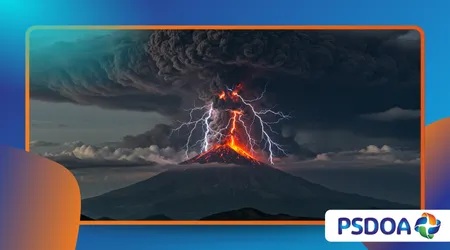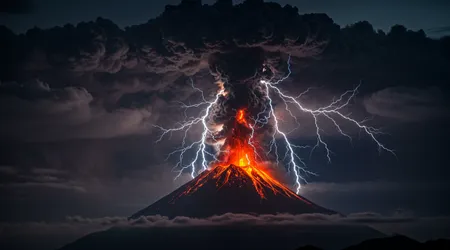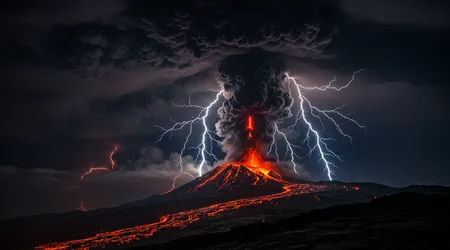Relámpagos volcánicos: cómo las nubes de ceniza crean sus propias tormentas

Relámpago volcánico crepita a través de imponentes columnas de ceniza, transformando las erupciones en espectáculos electrificados.
Anuncios
Este raro fenómeno, donde los volcanes generan sus propias tormentas, cautiva a científicos y espectadores por igual.
A diferencia de las tormentas eléctricas típicas, estos fenómenos surgen de la interacción caótica de ceniza, gas y calor extremo. ¿Por qué estas montañas ardientes provocan espectáculos eléctricos tan deslumbrantes?
Este artículo profundiza en la ciencia, la belleza y las implicaciones de relámpago volcánico, desentrañando cómo las nubes de ceniza se convierten en las centrales eléctricas de la naturaleza.
Desde observaciones antiguas hasta investigaciones modernas, exploraremos la mecánica de este fenómeno, su impacto en el medio ambiente y su papel en la configuración de nuestra comprensión de los sistemas dinámicos de la Tierra.
Anuncios
La ciencia detrás de los rayos volcánicos
En las profundidades de una erupción volcánica, se gesta el caos. Las partículas de ceniza, lanzadas al cielo, colisionan a gran velocidad, generando electricidad estática mediante un proceso llamado carga triboeléctrica.
Esta fricción, similar a frotar un globo en el cabello, crea partículas cargadas que generan chispas. relámpago volcánico.
A diferencia de las tormentas eléctricas comunes, que dependen del hielo y las gotas de agua, las columnas volcánicas se alimentan de ceniza seca y fragmentos de roca. La intensidad de estas colisiones genera descargas eléctricas que pueden eclipsar las tormentas típicas.
La altura de la columna es importante. Las columnas más altas, de más de 7 kilómetros, suelen transportar vapor de agua que se congela formando cristales de hielo, lo que facilita la separación de cargas.
Un estudio de 2015 sobre la erupción del volcán Calbuco en Chile reveló que se produjeron rayos a 100 kilómetros de distancia, impulsados por la formación de hielo en las partes superiores de la columna.
++ Círculos de hielo: esculturas giratorias de la naturaleza en ríos helados
Las columnas más pequeñas, más cercanas al respiradero, dependen de la electricidad generada por la fracturación de rocas. Este mecanismo dual hace... relámpago volcánico Únicamente versátil.
Imagínate caminar sobre una alfombra y tocar el pomo de una puerta. ¡Zap! Relámpago volcánico funciona a mayor escala, con partículas de ceniza actuando como alfombra y la atmósfera como pomo de la puerta.
¿El resultado? Rayos que pueden extenderse hasta 15 kilómetros, como se vio durante la erupción del volcán Augustine en 2008 en Alaska. Estos espectáculos eléctricos no son solo maravillas visuales; revelan la potencia bruta de las fuerzas geológicas de la Tierra.

El papel de las nubes de ceniza en la creación de tormentas
Las nubes de ceniza son el corazón de relámpago volcánicoCompuestas por finas partículas de tefra de menos de 2 milímetros, estas nubes forman columnas densas y turbulentas durante las erupciones explosivas.
Al colisionar los granos de ceniza, se desprenden de electrones, creando regiones de carga positiva y negativa. Esta separación, intensificada por el rápido ascenso de la columna, desencadena rayos que iluminan el cielo.
La erupción del Hunga Tonga de 2022 mostró los extremos de este fenómeno, produciendo 2.600 relámpagos por minuto en su punto máximo.
Estos destellos, nacidos en la estratosfera, ponen de relieve cómo las nubes de ceniza actúan como condensadores naturales, almacenando y liberando energía eléctrica.
A diferencia de las tormentas meteorológicas, las columnas volcánicas no necesitan humedad para generar chispas; la ceniza seca por sí sola puede encender el cielo.
Lea también: El destello verde: una ilusión óptica de una fracción de segundo al atardecer
Considere una columna volcánica como una batería gigantesca y caótica. Las partículas cargadas se arremolinan en su interior, impulsadas por el calor y la velocidad de la erupción.
Su entorno dinámico, sumado a las condiciones atmosféricas, amplifica la actividad eléctrica, haciendo relámpago volcánico un sello distintivo de erupciones explosivas como las del Monte Vesubio en el año 79 d.C., como señaló Plinio el Joven.
Impactos ambientales y atmosféricos
Relámpago volcánico No es solo un espectáculo visual; transforma el entorno. Las nubes de ceniza, cargadas de partículas cargadas, pueden alterar los patrones climáticos locales, provocando lluvia o granizo.
La erupción del Monte Pinatubo en 1991 enfrió las temperaturas globales en 0,5 °C durante casi dos años debido a las inyecciones de ceniza y dióxido de azufre.
Estas columnas también representan riesgos para la aviación. Las partículas de ceniza pueden obstruir los motores a reacción, mientras que los rayos amenazan los sistemas de navegación.
La erupción del volcán Eyjafjallajökull en Islandia en 2010 interrumpió los vuelos en toda Europa, lo que costó miles de millones a las aerolíneas. Relámpago volcánico Sirve como una señal de advertencia, ayudando a los científicos a monitorear el comportamiento de la columna y emitir avisos oportunos.
Leer más: Nubes de gloria matutina: las serpientes ondulantes del cielo
Más allá de la Tierra, relámpago volcánico Ofrece pistas para la ciencia planetaria. Los rayos en columnas extraterrestres, como los de Ío, la luna de Júpiter, sugieren mecanismos de carga similares.
¿Podrían estas chispas indicar condiciones para la vida? Esta pregunta impulsa la investigación, vinculando la actividad volcánica con misterios cósmicos.
Monitoreo y estudio de rayos volcánicos
Seguimiento relámpago volcánico Mejora la monitorización de erupciones. Los científicos utilizan detectores de ondas de radio para captar las señales electromagnéticas de los rayos, revelando la dinámica de las columnas incluso a través de la ceniza densa.
Durante la erupción del Hunga Tonga de 2022, los datos sobre rayos extendieron la duración conocida de la erupción de dos a once horas, lo que ayudó a realizar evaluaciones de peligros.
Los drones equipados con sensores se aventuran entre columnas volcánicas y recopilan datos en tiempo real sobre la distribución de la carga.
Estas herramientas, combinadas con imágenes satelitales, cartografian la dispersión de cenizas, crucial para la seguridad aérea. El radar terrestre y el infrasonido descifran aún más el caos eléctrico dentro de las columnas.
La siguiente tabla resume los principales eventos de rayos volcánicos y sus métodos de monitoreo:
| Erupción | Año | Destellos de relámpagos (pico) | Herramientas de monitoreo |
|---|---|---|---|
| Monte Vesubio | 79 d. C. | Desconocido | Relatos históricos |
| Monte Santa Helena | 1980 | 1 por segundo | Observaciones terrestres |
| Eyjafjallajökull | 2010 | Cientos | Satélite, detectores de ondas de radio |
| Tonga Hungaria | 2022 | 2.600 por minuto | Satélites, redes de detección de rayos |
Importancia cultural e histórica
Relámpago volcánico Ha maravillado a la humanidad durante siglos. El relato de Plinio el Joven sobre la erupción del Vesubio en el año 79 d. C. describió "llamas pasajeras" en la columna, mezclando miedo y asombro.
Las culturas antiguas a menudo veían estas manifestaciones como ira divina o presagios que daban forma a mitos y rituales.
Hoy, relámpago volcánico Cautiva a fotógrafos y cineastas. Un video viral de la erupción del Volcán de Fuego de 2024 en Guatemala, con rayos que se bifurcan entre las cenizas, despertó fascinación mundial. Estas imágenes unen la ciencia y el arte, resaltando la belleza natural de la naturaleza.
En contextos modernos, relámpago volcánico Informa sobre la preparación ante desastres. Las comunidades cercanas a volcanes activos, como las de Indonesia, utilizan datos sobre rayos para anticipar la caída de cenizas y los flujos piroclásticos.
Esta combinación de admiración ancestral y ciencia de vanguardia subraya el impacto duradero del fenómeno.

Ejemplos prácticos y analogías
Imagínese a un herrero forjando hierro, saltando chispas cuando el martillo golpea el metal. Relámpago volcánico refleja esto, con partículas de ceniza como martillo y la atmósfera como yunque, forjando pernos eléctricos.
Durante la erupción del Calbuco de 2015, los rayos iluminaron las nubes de ceniza, guiando los esfuerzos de evacuación en las aldeas cercanas.
Otro ejemplo: la erupción del volcán Chaitén en 2008, en Chile, produjo rayos que señalaron un cambio hacia una actividad más explosiva, lo que llevó a los científicos a emitir advertencias urgentes.
Como un telégrafo cósmico, relámpago volcánico comunica la intensidad de un volcán, facilitando la respuesta en tiempo real.
Imagine una columna volcánica como una botella de refresco agitada. La presión aumenta, las partículas colisionan y la energía se libera en una repentina explosión eléctrica.
Esta analogía captura la naturaleza dinámica e impredecible de relámpago volcánico, donde el caos alimenta el espectáculo.
Conclusión: El poder y el misterio de los rayos volcánicos
Relámpago volcánico Es más que un espectáculo fugaz; es una ventana a la energía pura de la Tierra. Desde cargas impulsadas por cenizas hasta rayos estratosféricos, este fenómeno revela la compleja interacción entre la geología y la atmósfera del planeta.
Su estudio mejora la seguridad, informa a la ciencia y fomenta el asombro. A medida que erupciones como la del Hunga Tonga traspasan los límites, relámpago volcánico sigue siendo un recordatorio del poder indómito de la naturaleza.
¿Desvelaremos algún día por completo sus misterios? Por ahora, sigue despertando curiosidad, conectando el asombro antiguo con el descubrimiento moderno.
Preguntas frecuentes
¿Qué causa los rayos volcánicos?
Es causada por partículas de ceniza que chocan en una columna volcánica, generando electricidad estática a través de carga triboeléctrica o formación de hielo en columnas altas.
¿Son peligrosos los rayos volcánicos?
Sí, representa riesgos para la aviación y las comunidades cercanas, anunciando erupciones explosivas y nubes de ceniza que pueden afectar los motores y la infraestructura.
¿Cómo se monitorean los rayos volcánicos?
Los científicos utilizan detectores de ondas de radio, satélites y drones para rastrear rayos y la dispersión de cenizas, mejorando los pronósticos de erupciones y las medidas de seguridad.
¿Pueden los rayos volcánicos afectar el clima?
Indirectamente, sí. Las nubes de ceniza pueden enfriar las temperaturas globales, como se vio con la caída de 0,5 °C del Monte Pinatubo, mientras que los rayos señalan el comportamiento de las columnas de ceniza.
¿Dónde puedo ver rayos volcánicos?
Ocurre durante erupciones explosivas en volcanes como el Vesubio, el Eyjafjallajökull o el Hunga Tonga, a menudo capturadas en videos virales o estudios científicos.
